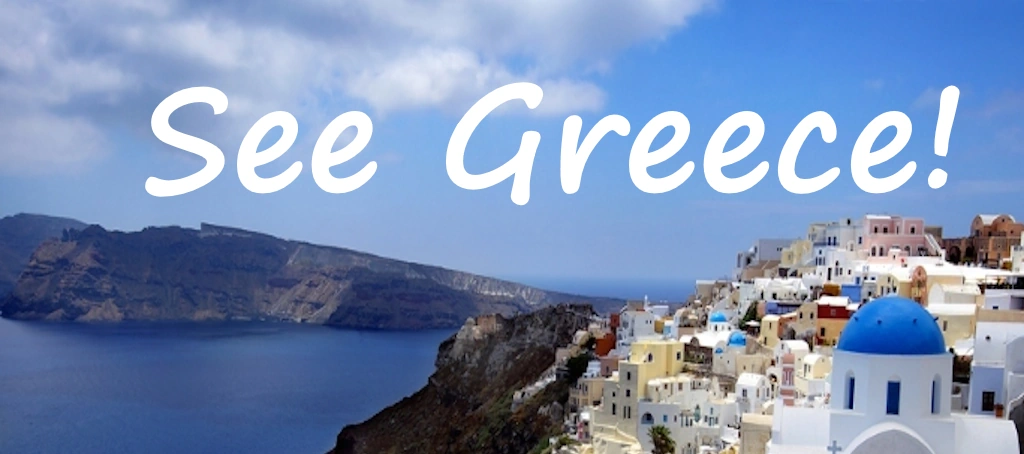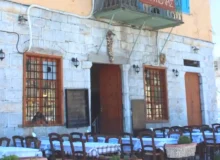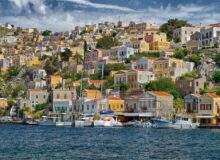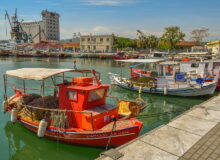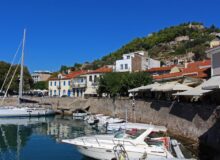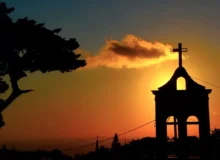Santorini Wineries
Visiting Santorini wineries is a popular activity on this Greek island in the Cyclades, whose volcanic soil provides a distinctive terroir.

Santorini Wineries: A Journey Through Volcanic Terroir and Ancient Traditions
Santorini, a jewel of the Cyclades in the Aegean Sea, is renowned for its breathtaking sunsets, whitewashed villages, and unique volcanic landscape. But beyond its iconic beauty lies a rich and deeply rooted winemaking tradition that has captivated people for millennia.
The island’s distinctive terroir, shaped by a cataclysmic volcanic eruption, has fostered a winemaking culture unlike any other, producing wines that are as singular and captivating as Santorini itself.

A History of Winemaking on Santorini
The story of winemaking on Santorini dates back an astonishing 3,500 to 4,000 years, making it one of the oldest wine-producing regions in the world. Archaeological evidence suggests that the Minoan civilization, which flourished before the island’s massive eruption around 1600 BC, cultivated vines and produced wine. While the eruption buried the island in a thick layer of volcanic ash, effectively wiping out all life, the resilient vines were eventually replanted, and winemaking resumed, a testament to the island’s enduring viticultural spirit.
During the Middle Ages, particularly under Venetian rule from the 13th to 16th centuries, Santorini’s wine trade truly flourished. Venetian merchants introduced the island’s wines to European markets, where they quickly gained a reputation for their intense acidity, minerality, and remarkable aging potential.
The sweet, sun-dried wine known as Vinsanto became a particularly prized export, even serving as the official Eucharistic wine for the Russian Orthodox Church for a period. This historical significance speaks volumes about the quality and longevity of Santorini wines.

One of the most remarkable aspects of Santorini’s wine history is its immunity to the phylloxera epidemic of the 19th century. Unlike most of Europe, where vineyards were decimated by this vine louse, Santorini’s unique sandy, volcanic soils acted as a natural barrier, preventing the parasite from surviving. As a result, many of the vines on Santorini are ungrafted and centuries old, contributing to the unparalleled depth and complexity found in the island’s wines today. This ancient lineage gives Santorini an almost mythical quality in the wine world.
Traditional viticultural practices, such as the unique “kouloura” vine-training system, have been preserved and perfected over generations. This method involves weaving the vines into low-lying, wreath-like baskets on the ground, protecting the grapes from the island’s strong winds, scorching sun, and minimal rainfall, while also capturing the nocturnal sea mist for essential moisture. This ingenious adaptation to the harsh environment is a cornerstone of Santorini’s winemaking heritage.
Today, Santorini’s winemakers skillfully blend these ancient traditions with modern technology, producing world-class wines that continue to gain international recognition. The island’s dedication to its indigenous grape varieties and unique terroir ensures that Santorini remains a vital and fascinating region for wine enthusiasts.

The Taste of Volcanic Earth: Typical Santorini Wines
Santorini’s wines are truly a reflection of their volcanic origin, offering a sensory experience unlike any other. The island’s unique soil, high temperatures, strong winds, and limited rainfall contribute to wines with distinctive characteristics.
Assyrtiko: This white grape variety is the undisputed queen of Santorini and accounts for the vast majority of the island’s vineyard plantings. Assyrtiko wines are celebrated for their bracingly high acidity, often described as “piercing” or “razor-sharp,” which gives them incredible freshness and longevity. They typically exhibit intense minerality, often evoking notes of wet stone, flint, and a distinctive salinity, a direct influence of the volcanic soil and sea air. Aromas lean towards citrus, particularly lemon and grapefruit, sometimes with hints of green apple or passionfruit.
While most Assyrtiko is fermented and aged in stainless steel to preserve its crispness and purity, some producers also create oaked versions, known as Nykteri. These barrel-aged Assyrtikos develop greater complexity, with notes of toasted nuts, honey, and a richer texture, while still retaining their signature acidity. Assyrtiko’s vibrant character makes it an ideal pairing for the island’s fresh seafood cuisine.
Nykteri: A Protected Designation of Origin (PDO) wine, Nykteri is a dry white wine made primarily from Assyrtiko grapes (at least 75%), often blended with smaller percentages of Athiri and Aidani. Traditionally, Nykteri grapes were harvested at night (hence “nykteri,” meaning “night” in Greek) to avoid the intense daytime heat.
These wines are typically aged in oak barrels for at least three months, resulting in a more full-bodied wine with a richer texture, heightened aromas of citrus peel and honey, and a longer, more complex finish.
Vinsanto: This naturally sweet dessert wine is arguably Santorini’s most famous and historically significant wine. Vinsanto (a name derived from “Vino di Santo” or “wine of Santorini”) is made from sun-dried grapes, primarily Assyrtiko, Athiri, and Aidani. After harvesting, the grapes are laid out in the sun for 7 to 15 days to dehydrate, concentrating their sugars and flavors.
The resulting must undergoes a slow fermentation, often lasting several months, and is then aged in oak barrels for a minimum of two years, though many Vinsantos are aged for significantly longer. The long aging process contributes to its characteristic amber color and complex aromas of dried fruits (apricot, fig, raisin), honey, caramel, coffee, and spices. Vinsanto offers a rich, velvety texture and a delightful balance of sweetness and acidity, making it a truly exceptional dessert wine, perfect for savoring on its own or with rich cheeses and desserts.
Athiri & Aidani: These are other indigenous white grape varieties found on Santorini. Athiri produces lighter, more aromatic white wines with floral and citrus notes, while Aidani contributes delicate floral aromas and a subtle sweetness. Both are often blended with Assyrtiko to add complexity and aromatic nuances to dry white wines.
Mavrotragano & Mandilaria: While Santorini is predominantly known for its white wines, there are also a few red varieties. Mavrotragano is a rare red grape gaining recognition for producing intensely colored, full-bodied wines with firm tannins and aromas of dark fruit, herbs, and spices. Mandilaria, another red grape, offers deep color and high tannins, often contributing to robust blends.

Uncorking the Experience: Booking Santorini Wine Tours
For any visitor to Santorini, a wine tour is an absolute must-do. It offers a unique opportunity to delve into the island’s liquid history, witness its distinctive viticultural practices at first hand, and, of course, taste the exceptional wines. Booking a wine tour in Santorini is straightforward, with a variety of options to suit different preferences and budgets.
Many tour operators specialize in wine experiences, offering both small-group and private tours. These typically include transportation to several wineries, guided tours of the vineyards and cellars, and multiple wine tastings, often paired with local cheeses, cured meats, and traditional Greek meze (appetizers). Some tours even incorporate a sunset viewing at a scenic caldera-edge winery, combining two of Santorini’s most iconic experiences.

You can book wine tours online through various tour aggregation websites or directly on the websites of individual wineries. It’s advisable to book in advance, especially during the peak tourist season (May to September), as popular tours and wineries can fill up quickly. Many tour companies offer flexible booking options, including “book now, pay later” policies and free cancellation up to a certain point.
When booking, consider the duration of the tour, the number of wineries visited, the types of wines offered for tasting, and whether food pairings are included. Private tours offer more flexibility in terms of itinerary and pace, while small-group tours provide a social atmosphere and are generally more cost-effective. Don’t hesitate to check reviews and compare options to find the perfect Santorini wine adventure for you.

Gems of the Vine: Main Santorini Wineries to Visit
If you want to go it alone, Santorini boasts an impressive collection of wineries, each with its own charm, history, and unique offerings. Here are some of the main wineries that are highly recommended for visitors:
Santo Wines: As the largest producer on the island, Santo Wines is a cooperative winery representing the majority of Santorini’s grape growers. Perched dramatically on the caldera cliffs in Pyrgos, it offers breathtaking panoramic views, especially at sunset.
Santo Wines provides a comprehensive tasting experience, showcasing a wide range of their PDO Santorini wines, including various Assyrtiko expressions and their renowned Vinsanto. Their facility is modern and well-equipped, with a restaurant that pairs local dishes with their wines.

Domaine Sigalas: Located in the northern part of the island near Oia, Domaine Sigalas is a boutique winery celebrated for its commitment to quality and innovation. Founded by Paris Sigalas, a pioneer in modern Santorini winemaking, the winery is known for its exceptional Assyrtiko wines, including single-vineyard expressions and oak-aged versions.
They also produce excellent Aidani and a highly regarded Vinsanto, as well as some excellent red wines from Mavrotragano. The winery offers a beautiful tasting room and often hosts food pairing experiences with local delicacies.
Estate Argyros: With a history dating back to 1903, Estate Argyros is one of the oldest and most respected wineries on the island, owning some of the oldest ungrafted vineyards. Located in Episkopi Gonia, the fourth generation of the Argyros family now runs the estate, focusing on crafting high-quality, age-worthy wines.
They are particularly renowned for their exquisite Vinsanto, which can be aged for many years, as well as their powerful and elegant dry Assyrtikos. Their new, modern winery provides a stunning backdrop for tasting their exceptional portfolio.

Venetsanos Winery: Perched on a cliff overlooking the caldera in Megalochori, Venetsanos Winery holds the distinction of being Santorini’s first industrial winery, built in 1947. Its unique architectural design, built from the top down, allowed for gravity-flow winemaking long before it became a popular concept.
The winery offers fascinating historical tours of its subterranean cellars and provides stunning views during wine tastings, particularly at sunset. They produce a range of acclaimed white and red wines, blending tradition with a forward-thinking spirit.
Gaia Wines: Situated directly on the beach on the island’s eastern coast, Gaia Wines offers a unique “beach winery” experience. Housed in a renovated tomato processing plant, Gaia focuses on producing high-quality Assyrtiko, including their popular “Thalassitis” (meaning “from the sea”) and a “Wild Ferment” Assyrtiko. Their location allows visitors to enjoy wine tastings with the sound of the waves as a backdrop, and they also produce an excellent Vinsanto.

A Journey through Time: The Koutsogiannopoulos Wine Museum
Nestled in a natural cave eight meters below ground, the Koutsogiannopoulos Wine Museum offers a fascinating and immersive journey into Santorini’s winemaking past. Located in the village of Vothonas, this unique museum is the creation of the Koutsogiannopoulos family, who have been making wine on the island for four generations, dating back to 1870. It took the family 21 years of meticulous work to excavate and transform this 300-meter-long labyrinthine cave into a captivating exhibit space.
The museum meticulously recreates the traditional winemaking process through a series of engaging dioramas and authentic artifacts, ranging from antiquated grape presses and distilling equipment to primitive bottling machines. Visitors are guided through the various stages of production, learning about the challenges and ingenuity involved in crafting wine on the island from the late 1600s to the mid-1900s.
The exhibits are accompanied by narratives and family records, deeply connecting the museum experience to the Koutsogiannopoulos family’s enduring story and their dedication to preserving Santorini’s winemaking heritage.
Beyond the historical displays, the museum also showcases how the Koutsogiannopoulos family has adapted modern technologies while maintaining the exceptional quality of their wines. A visit typically concludes with a wine tasting of the family’s current productions, including their renowned Assyrtiko, Vinsanto, and other local varieties.
The museum is open year-round, with extended hours during the peak season, and offers guided tours in multiple languages, making it accessible to a wide international audience. Pre-booking is recommended, especially during busy periods, to ensure availability.
The Koutsogiannopoulos Wine Museum is not just a collection of artifacts; it’s a living tribute to the ingenuity, perseverance, and passion that define Santorini’s extraordinary winemaking legacy. It offers a truly unique perspective on the island’s culture, enriching any visit to this remarkable Cycladic gem.
